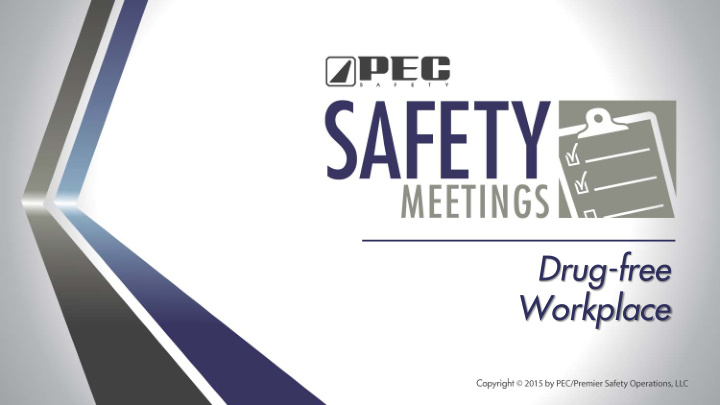



Drug-free Workplace
Drug and alcohol use are recognized hazards OSHA’s General Duty Clause states that all workers must be provided a workplace that is free of recognized hazards Companies put drug-free workplace programs in place to keep workers safe PPT-SM-DFWP 2015 2
Drug-free workplace programs usually include A written drug-free workplace policy Supervisor training Worker education Worker assistance Drug testing and search policies Consequences of policy violations PPT-SM-DFWP 2015 3
As part of the drug-free workplace program, your company may drug test you Pre-employment Post-accident Randomly Reasonable suspicion Return-to-duty Follow-up PPT-SM-DFWP 2015 4
The drug-free workplace program may also detail the company’s right to search property, workers, and workers’ properties on site PPT-SM-DFWP 2015 5
Companies may perform searches if they suspect a worker has Unauthorized medication Drugs and drug paraphernalia Alcohol Other forbidden items PPT-SM-DFWP 2015 6
If you violate the drug-free workplace program , you could lose your job or be referred for treatment and assistance PPT-SM-DFWP 2015 7
Drug-free workplace programs are important because substance abuse can endanger the user, other workers, the company, and the public Almost 40% of industrial fatalities and 50% of work-related injuries are linked to drug and alcohol impairment Industrial fatalities Work-related injuries PPT-SM-DFWP 2015 8
Signs of substance abuse can be 1. Physical 2. Behavioral 3. Psychological PPT-SM-DFWP 2015 9
Physical signs of substance abuse can include Bloodshot eyes Changes in grooming habits or personal care Dilated or pinpointed pupils Frequent nosebleeds Sudden changes in weight Shaking, slurred speech or poor coordination Strange smells on the breath, body, or clothes PPT-SM-DFWP 2015 10
Behavioral signs of substance abuse can be Decline in work performance Sudden lack of motivation Complaints from coworkers Random requests for money Withdrawing from coworkers Frequent arguments PPT-SM-DFWP 2015 11
Psychological signs of substance abuse can be Mood swings Random bouts of agitation or hyperactivity Unexplained personality or attitude changes Unusual lack of focus PPT-SM-DFWP 2015 12
70% of all illegal drug users are employed 1 in 12 full-time workers report current drug use This means that any job can expose you to the hazards of substance abuse PPT-SM-DFWP 2015 13
Protect yourself from workplace substance abuse by Knowing the signs of substance abuse Seeking help if you need it PPT-SM-DFWP 2015 14
If you need help to overcome substance abuse, there are resources available , including national hotlines and community resources Some companies may offer Employee Assistance Programs (EAPs) PPT-SM-DFWP 2015 15
EAPs provide confidential help to workers to overcome substance abuse PPT-SM-DFWP 2015 16
You can call the Substance Abuse and Mental Health Services Administration’s (SAMHSA) national hotline at 1-800-622-HELP (4357) PPT-SM-DFWP 2015 17
Community resources available for workers may include Counseling Rehab and treatment Local self-help groups like Alcoholics Anonymous (AA) and Narcotics Anonymous (NA) PPT-SM-DFWP 2015 18
Workers must be drug and alcohol free to work safely Follow your company’s drug-free workplace program Look for signs of substance abuse in your workplace If you need help to overcome substance abuse, help is available for you PPT-SM-DFWP 2015 19
20
Recommend
More recommend